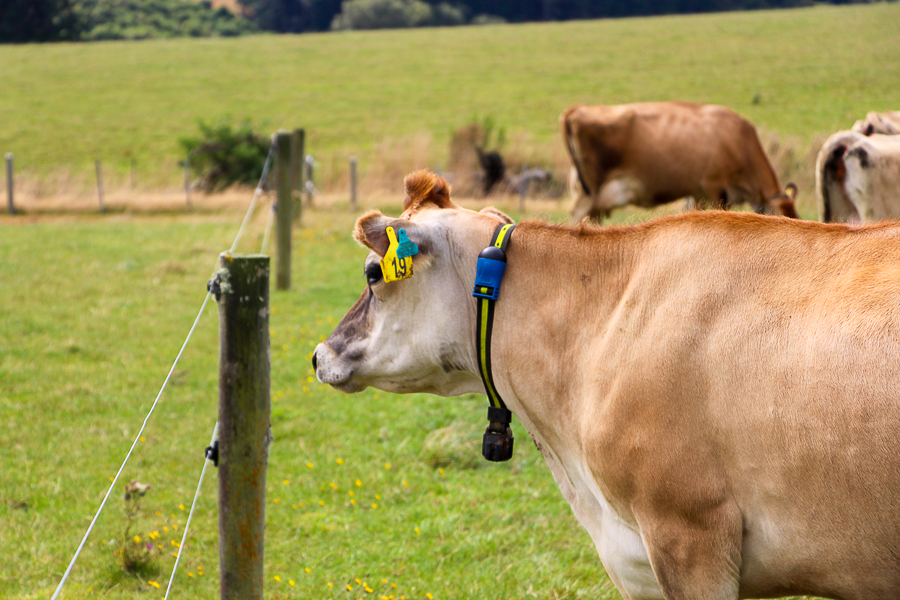
The transition period, often defined as the period from three weeks before until three weeks after calving, is a challenging time for the health and performance of a dairy cow. Metabolic and reproductive health issues within the transition period are common and can cause a reduction in productivity and increases in costs and losses even before the season has really begun.
Cow monitoring technology is proving to be a useful tool for monitoring health status during the transition period. By measuring each cow individually, it is now possible to assess cow wellbeing prior to changing from once-a-day to twice-a-day milking; allowing cows with a longer recovery to remain in the once-a-day herd if necessary.
Proper rumen function is key to the health and productivity of a dairy cow. Some research suggests that a quick recovery after calving supports a higher peak milk production. This theory is yet to be tested in a pastoral, seasonal dairy system such as our own but research aside, a cow with uneventful calving, no incidence of disease and a normal recovery will undoubtedly produce more milk faster than a cow that is struggling. Furthermore, she is likely to recover in time for mating, which in turn means a higher likelihood of pregnancy – in essence, the very thing that is required of a high-performing New Zealand dairy cow.
You may have considered leaving your cows on once-a-day milking for longer to aid recovery after calving. Some work has shown a higher rumination time in cows milked once a day after calving and higher six-week in-calf rates in cows with relatively higher rumination time post-partum within the same herd; suggesting that it could be beneficial to milk the colostrum cows once-a-day for longer. The thinking behind this is sound: higher rumination time indicates a higher feed intake, reducing the severity of negative energy balance and therefore the risk of post-partum disease. With collars, you can assess this for each individual cow, at any time after calving.
It is important to understand that rumination is an indicator of animal performance and welfare. Achieving high rumination times alone is not the target. If that was the case, an ideal diet would consist of straw alone!
Milking your colostrum cows once a day does not fix an underlying metabolic issue or remove a retained membrane. The rumination time would, however, indicate that these cows are not recovering well and may need assistance. Once-a-day milking will support the cow by requiring less walking, allowing more grazing time, reducing stress and thereby aid in the recovery post-calving.
By monitoring rumination time, you will be alerted if a cow is dealing with an issue that is causing her health or wellbeing to be affected – an indication that she is not yet at a point where she can compete with her fully recovered herd mates. For cows with less severe challenges than the ones described above, once-a-day milking may be enough to support a return to optimum rumen function without further intervention. Utilising rumination time to assess individual cows post-partum will ensure that the cow’s health status is considered, giving her the best possible start to the season.
There is no one-size-fits-all when it comes to post-partum rumination times – it depends on your sensor type, the composition of your herd and your overall objectives. Generally, rumination times above 380 min/day are considered high enough for the change from OAD to TAD, provided that the rumination time is on an upwards trend. Farmers can choose if they check RT on a certain day (for example, eight days after calving) or on any day after calving, ensuring that cows are drafted as soon as they are recovered. It is of course important to consider withholding times, staff on hand, time availability and group management.
It is important to consider sensor type when establishing a threshold. Your system may combine rumination and eating time, in which case you would base your decision-making around this measure instead.
Proper rumen function is key to the health and productivity of a dairy cow. Changes in rumination patterns cannot be used to diagnose a specific disease but can be used as a general indicator of a change in health status or comfort that merits further investigation. It is a powerful tool in improving our current transition cow management and may lead to improved per cow production and reproductive outcome in the herd. With animal monitoring, you have more flexibility in deciding when to change cows from OAD to TAD and do not have to rely on a standardized post-partum strategy.
If you would like to discuss this or any other matter related to collar technology and animal monitoring systems, get in touch with your farm vet or contact our specialised animal monitoring branch directly on cowsmart@vetlife.co.nz